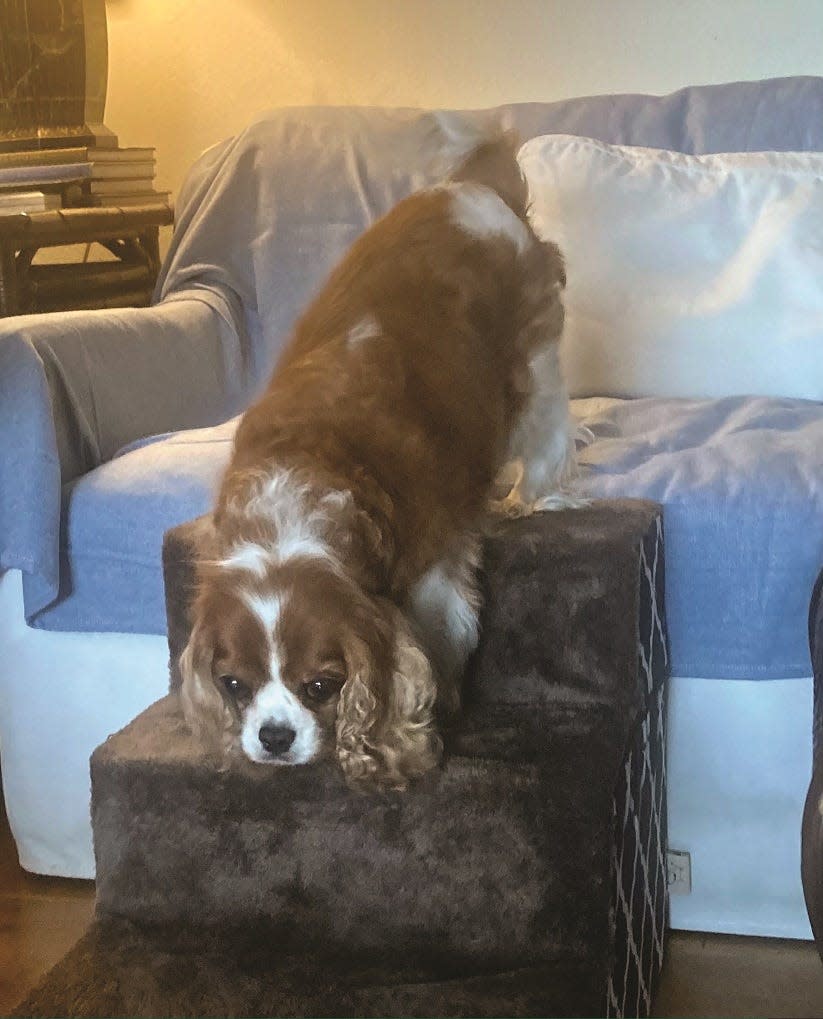Pet Steps: Why they can be important and what to look for when purchasing

My dog Sparkles celebrates her 11th birthday in a couple of weeks, but you’d never know it to look at her. She races up and down the stairs and jumps on and off the sofa with gusto. The jumping off the sofa bit worries me, though. It’s hard on dogs’ joints and can lead to injuries or arthritis, especially if you have slick wood floors that aren’t softened by an area rug. And some older dogs can have difficulty getting on sofas or beds that they used to jump onto with ease.
Pet steps to the rescue! And you might be surprised to learn that they’re not just for older dogs, small dogs or dogs with orthopedic problems. Any pet can benefit from an assist when it comes to getting on and especially off furniture or in and out of cars.
“There has been one published study that I know of that showed that dogs can get injuries indistinguishable from elbow dysplasia, which creates just about the worst arthritis a dog can get, by jumping down from SUVs onto hardtop,” says veterinarian Chris Zink, past president of the American College of Veterinary Sports Medicine and Rehabilitation. “This is the reason why I never let my dogs of any size jump out of my car. With the larger dogs, I just teach them to fall into my arms as I let them down to the ground. It isn’t as difficult as picking a dog up.”
Whether you have a tiny Chihuahua puppy or a giant Scottish deerhound, pet steps can help to prevent injuries as well as save your own back. As Zink says, “Why risk injury when there are simple alternatives?” Here’s what to look for.
• Materials. Pet steps can be made of foam, plastic or wood. We chose foam because it’s lightweight and we move the steps back and forth daily from the sofa to the bed. Plastic steps can be slippery. Choose steps with a carpeted or nonslip surface. The bonus is that some are made to fold down for easy storage or transportation. Wooden steps can be attractive and are sturdy enough for large dogs. Drawbacks include cost and weight. Lightweight is good, but stability is important, too.
• Safety. Steps or ramps should have a nonskid surface, and the bottom should be nonskid, too. We had to attach nonskid material to the bottom of the steps we purchased so they didn’t slide when Sparkles stepped on them.
“Nonslip is the most important thing,” Zink says. “Ease of use comes second. Having it wide enough for the really giant breeds is a plus, but regardless, the giant dogs should be guided down to be sure they don’t slip off the sides.”
• Ease of cleaning. Steps can start to look grungy with regular use. Some have removable covers that can be machine washed or taken to the dry cleaners. Carpeted surfaces can be vacuumed. Wipe down plastic steps with soap and water and dry thoroughly. Be sure not to clean wooden steps with products that will leave them feeling slippery.
• Height. Be sure the depth and angle of the steps are comfortable for your pet. Our 16-inch steps are level with the sofa. They don’t take Sparkles all the way up to the bed, but it’s easy for her to jump onto it from the third step. Some people keep a taller set of steps by the bed and a shorter set by the sofa.
• Cars. Ramps are popular for aiding dogs in getting in and out of cars, especially vans and SUVs that are high off the ground. Take into account the same safety considerations. Be aware, though, that some dogs simply prefer steps.
Now we just need to get Sparkles to remember to go down her steps.
— By Kim Campbell Thornton
This article originally appeared on South Bend Tribune: Pet Connection: All dogs or cats can benefit from pet steps

